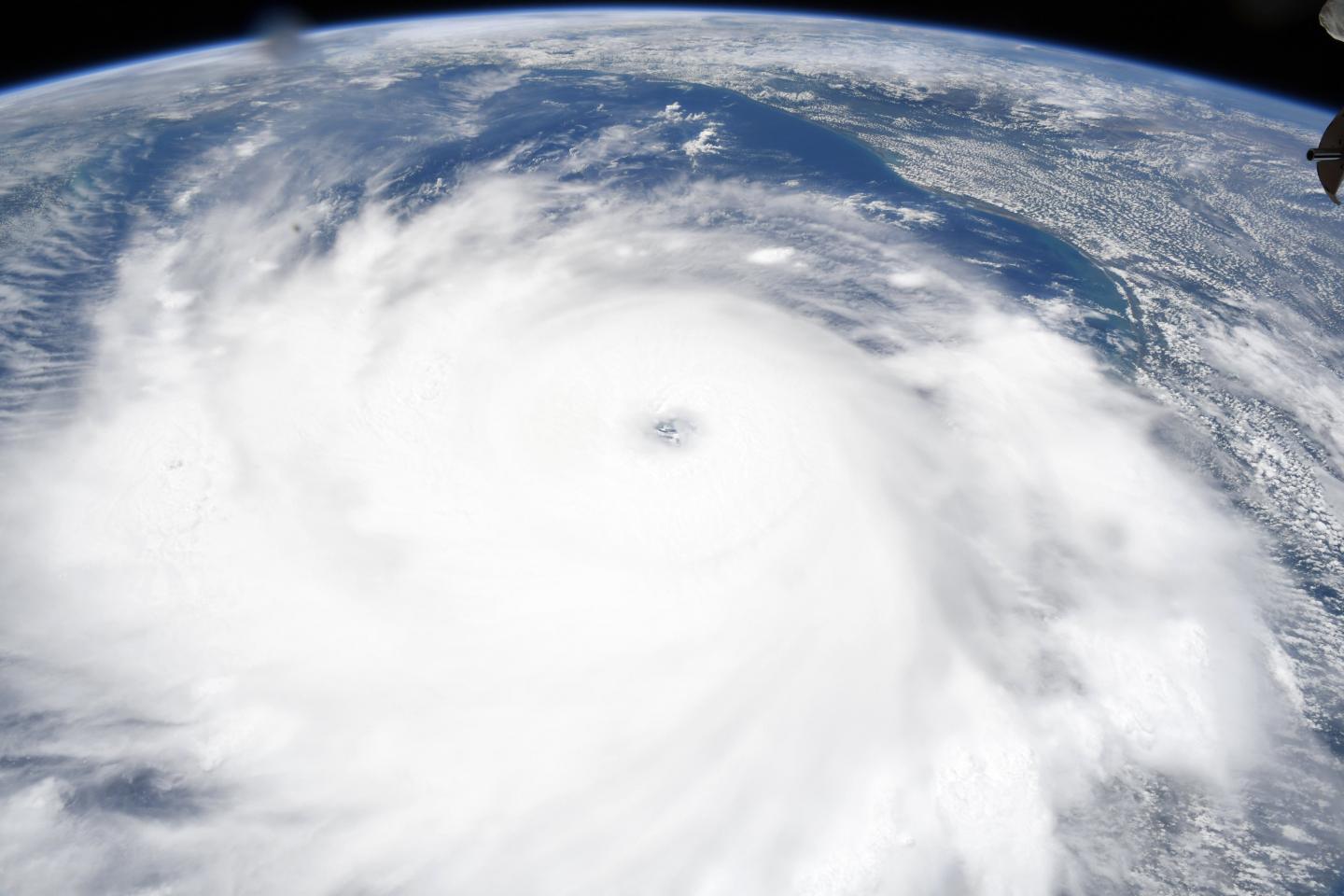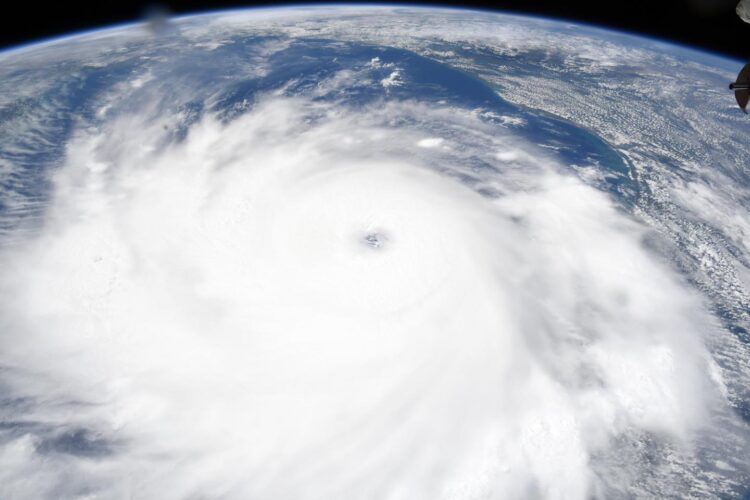
Credit: Credit: NASA/Chris Cassidy
Many NASA assets were used to provide forecasters with information to incorporate into their analysis of Hurricane Laura. Satellite imagery, photographs from the International Space Station, and a computer program that produces animations of imagery are all things that NASA used to analyze the storm. NASA-NOAA’s Suomi NPP satellite also caught a nighttime image of Laura just after landfall.
Laura’s Landfall
Laura made landfall as a powerful Category 4 hurricane along the Louisiana coast. At 2 a.m. EDT (0600 UTC) on Aug. 27, Doppler radar images indicated that the eye of Hurricane Laura made landfall at the coast near Cameron, Louisiana, near latitude 29.8 degrees north and longitude 93.3 degrees west. Air Force reconnaissance and Doppler radar data indicated that the maximum sustained winds were near 150 mph (240 kph) with higher gusts. National Hurricane Center (NHC) Senior Hurricane Specialist John Cangialosi and Hurricane Model Diagnostician and Meteorologist David Zelinsky noted, “At the time of landfall, Laura was a ferocious looking hurricane with a clear circular eye, an intense eyewall, and tightly-coiled surrounding spiral bands.”
A Nighttime View of Laura’s Landfall
NASA-NOAA’s Suomi NPP satellite passed over Hurricane Laura soon after it made landfall in southwestern Louisiana around 2 a.m. EDT on Aug. 27. The Visible Infrared Imaging Radiometer Suite (VIIRS) instrument aboard Suomi NPP captured a nighttime image. Laura’s cloud cover extends from Houston, Texas east to just west of New Orleans, Louisiana.
Weather Station Reports Just After Landfall
A National Ocean Service tide station at Calcasieu Pass, Louisiana observed a water level rise of 9.19 feet Mean Higher High Water at 1 a.m. CDT/2 a.m. EDT. The Lake Charles, Louisiana airport reported a sustained wind of 85 mph (137 kph) with a gust to 128 mph (206 kph) around 2 a.m. CDT/3 a.m. EDT. A University of Florida observing tower near Lake Charles recently reported a sustained wind of 86 mph (138 kph) with a gust to 112 mph (180 kph). A Texas Coastal Ocean Observing Network site at Sabine Pass on the Texas/Louisiana border reported sustained winds of 74 mph (119 kph) with a gust to 90 mph (145 kph).
Watches and Warnings on Aug. 27, 2020
A Storm Surge Warning is in effect for High Island, Texas to the mouth of the Mississippi River.
A Tropical Storm Warning is in effect for High Island, Texas to the mouth of the Mississippi River.
Animating Hurricane Laura’s Path to Landfall
The Visible Infrared Imaging Radiometer Suite (VIIRS) instrument aboard Suomi NPP provided a visible imagery of Laura from its birth in the Atlantic. Using the Worldview application at NASA’s Goddard Space Flight Center in Greenbelt, Md., an animation was created of Laura’s track from Puerto Rico to Louisiana. The imagery spanned from Aug. 20 to 26 and showed Tropical Storm Marco move from the Caribbean Sea to a landfall near the mouth of the Mississippi while Tropical Storm Laura moved from the east over Puerto Rico, Hispaniola and into the Gulf of Mexico, just before landfall in southwestern Louisiana.
NASA’s Earth Observing System Data and Information System (EOSDIS) Worldview application provides the capability to interactively browse over 700 global, full-resolution satellite imagery layers and then download the underlying data. Many of the available imagery layers are updated within three hours of observation, essentially showing the entire Earth as it looks “right now.”
A View from the International Space Station
Astronaut Chris Cassidy aboard the International Space Station took several photos of Hurricane Laura as it neared the Gulf coast on Aug. 26, 2020 at 3:27 p.m. EDT. The photos showed the extent of this large hurricane. The photos also revealed a clear eye surrounded by powerful thunderstorms. The photo below is one of four taken by Cassidy from the ISS.
Laura’s Status on Aug. 27 at 8 a.m. EDT
At 8 a.m. EDT (1200 UTC), the center of Hurricane Laura was located near latitude 31.2 degrees north and longitude 93.3 degrees west. That is about 20 miles (30 km) north of Fort Polk, Louisiana.
Laura is moving toward the north near 15 mph (24 kph) and this motion should continue through the day. A northeastward to east-northeastward motion is expected tonight and Friday. Maximum sustained winds are near 100 mph (160 kph) with higher gusts. Laura is now a Category 2 hurricane on the Saffir-Simpson scale at present based on wind speed.
Hurricane-force winds extend outward up to 60 miles (95 km) from the center and tropical-storm-force winds extend outward up to 175 miles (280 km). An observing site in Alexandria, Louisiana, recently reported a wind gust to 74 mph (119 kph).The estimated minimum central pressure is 970 millibars.
Laura’s Forecast and Track
NHC warned about dangerous storm surge, heavy rainfall, hurricane-force winds and isolated tornadoes.
NHC said, “The combination of a dangerous storm surge and the tide will cause normally dry areas near the coast to be flooded by rising waters moving inland from the shoreline. The water could reach the following heights above ground somewhere in the indicated areas if the peak surge occurs at the time of high tide.
Through Friday, forecasters expect Laura to produce the following rainfall totals: Across portions of Louisiana, Mississippi, across Arkansas: 6 to 12 inches with isolated totals of 18 inches. This rainfall will cause widespread flash and urban flooding, small streams and creeks to overflow their banks, and minor to moderate freshwater river flooding.
Hurricane-force winds and damaging wind gusts are also expected to spread well inland into portions of eastern Texas and western Louisiana this morning. Tropical storm conditions will spread northward within the warning areas through the day.
In addition, tornadoes are possible today and tonight over parts of Louisiana, Arkansas, and western Mississippi.”
Rapid weakening is forecast, and Laura is expected to become a tropical storm later today (Aug. 27). On the forecast track, Laura will move northward across western and northern Louisiana through this afternoon. The center of Laura is forecast to move over Arkansas tonight, the mid-Mississippi Valley on Friday, and the Mid-Atlantic States on Saturday.
NASA Researches Tropical Cyclones
Hurricanes/tropical cyclones are the most powerful weather events on Earth. NASA’s expertise in space and scientific exploration contributes to essential services provided to the American people by other federal agencies, such as hurricane weather forecasting.
For more than five decades, NASA has used the vantage point of space to understand and explore our home planet, improve lives and safeguard our future. NASA brings together technology, science, and unique global Earth observations to provide societal benefits and strengthen our nation. Advancing knowledge of our home planet contributes directly to America’s leadership in space and scientific exploration.
For Key Messages and updated forecasts, visit: http://www.
###
Media Contact
Rob Gutro
[email protected]
Original Source
https:/





